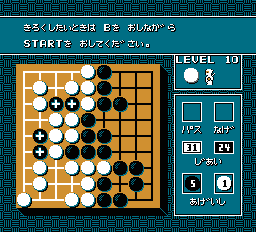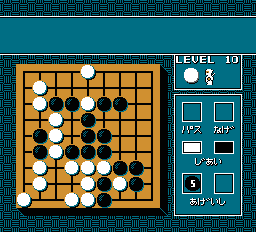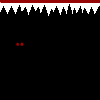囲碁 九路盤対局 is one of the many Famicom games
designed to tutor or play the Game of Go. (圍棋 or 围棋 for the Chinese folks.)
Go is a board game that enjoys a fame in oriental countries comparable
to that of Chess in European and American countries. In Go, the objective
is to surround territory and to capture opponent's pieces, "stones", by
depriving them of liberties. The player who scores more points this way, wins.
Go is one of the board games that have not been solved yet (i.e. the perfect
play is not known). Furthermore, so far, nobody in the world has been able
to write a computer program that plays Go better than an average club player.
Therefore, in a TAS of a Go game, the skills of the player play a much
more important part than the fact that you can use any tools.
You can use whatever tools you wish, but still you need to actually be
a good player if you intend to beat your opponent.
More information about the Game of Go:
The objective of this movie:
- To beat the computer player as fast as possible with as high level as possible.
Other information:
- Luck manipulation was not used.
- To beat this movie, either beat the computer with a higher level, or equal level but faster than I did.
The levels in this game work like this:
- At level 1, you receive 5 handicap stones (i.e. you have 5 stones on board when the opponent makes its first move). You go first.
- At levels 1-4, you receive 5, 4, 3 or 2 handicap stones respectively. You go first.
- At level 5, the game is even but you go first.
- At level 6, the game is even but the computer goes first.
- At levels 7-14, the computer receives 2, 3, 4, 5, 6, 7, 8 or 9 handicap stones respectively. The computer goes first.
I played on level 10: It is the setting with which I usually play against complete beginners, and I expect the computer player to be significantly better than a beginner human player.
Note: Go is normally played on a 19x19 board. This game plays on 9x9 board, which is more commonly used for short games and/or training. It may be probably more suitable for TASes than the 19x19 board.
Move-by-move explanation of this movie are below. My coordinate system is horizontally ABCDEFGHJ from left to right, vertically 123456789 from up to down.
- Five handicap stones were placed in the standard positions. Computer is black, I am white.
- E3: A rather normal beginning move on 9x9 board acquiring some foothold.
- F4: A perfectly valid response that any strong player could do in the same situation.
- F7: I suspect the computer is better at playing local situations than it is at thinking ahead the relationships between different areas of the board, so I start another attack in the lower right corner.
- F5: The computer thinks it is better to strengthen the upper right corner and the center than the corner I just attacked. But it is also keeping an eye on the F7 stone, so it is not entirely bad.
- C6: Played in the same spirit as the F7 stone earlier.
- F6: The computer thought this for a long time, and then made a bad move. Perhaps it thought, better late than never. Nevertheless, the right edge is pretty safe for the computer now. I think, by now, I have already gained back one of the handicap stones' advantage. It is a bad move because of the famous empty triangle shape, and because black is overconcentrated, compared to white.
- E7: Makes the F7 stone stronger by increasing its liberties, and increases the pressure on the lower left corner.
- E6: Another blunder from the computer. An empty triangle shape is not improved by making another horrible shape. It is now very obvious that black is overconcentrated: Many stones in a small lump. I did a look afterwards and saw that another move the computer thought about was D7: It would have been a lot better indeed.
- D7: The computer did not play this spot, so I played it. Again it strengthens the white stones already there, and puts more pressure on the lower left corner.
- B6: The computer finally realized the danger on the lower left corner, and tries to do something about it. Unfortunately, it is a little late for that because white is already strong there, thanks to the last two moves. A better move could have been B7 (to protect that corner), or perhaps B5 (to take a claim on the upper left edge).
- B7: I threaten to capture black's C7 stone. The text that flashes, "あたり" (atari) means that C7 stone could be captured on white's next move because it only has one liberty left. (Yes, name of the game company Atari comes from exactly this term.)
- C8: Black does not want to be captured, so he extends, increasing the liberties of the threatened C7 stone by two. No longer in atari.
- B8: C8 was what I expected black to play, and this is what I planned to play next. It keeps the attack on the C7-C8 string and threatens to atari the B6 stone as well.
- B5: I thought black is going to play D8, to prevent white playing there. I think B5 is a good play. It prevents the attack I was planning for the B6 stone, and it also forbids me from playing elsewhere: if I ignore the lower left corner situation, black is going to play D6 next, which would mean death for all the white stones in the lower left corner.
- E5: My options were D6, D8 and E5.
- If I played D6, the next moves would be D8, E8, C5. I would lose my chances of getting anything good in the upper left corner.
- If I played D8, the computer would play D6 next, forcing me to capture at C9 sooner or later. I didn't think it's a good option.
- E5 increases white's liberties and potential for upper left corner attacks.
- The computer responds at D8, thinking it can get away. Unfortunately I have already calculated it, and black will find an unfavorable shortage of liberties that will lead into the capture of the C7-C8-D8 string.
- With E8, I keep the balance of liberties in the lower left corner in my favor.
- Black cuts at D6. This is generally speaking a smart move, but as the black stones in the lower left corner are practically captured already, black should have played C4 instead. I think, at this point, I have gained back the advantage of three or four of the handicap stones black had.
- D9: This or C9 was a mandatory move, keeping the balance of liberties in white's favor. Otherwise, black could have captured either the C5-D6 string or the D7-E7-D9-E8 string, saving the doomed C7-C8-D8 string. Black is now in atari.
- C9: A stupid move. Black is still in atari! The computer probably thought singlemindedly about the atari it placed on the white D9 stone.
- E9: Instead of capturing the black stones, I protected the ataried stone. I also contemplated on ignoring the local situation and playing elsewhere, but it seems doing so would have lead into my loss.
- B9: Another stupid move. Black is still in atari! This move accomplished precisely nothing. I have now gained back surely four of the five handicap stones' value.
- C4: This move increases the liberties of the white C5-C6 string and opens an attack at the upper left corner, possibly with the aid of to the long-neglected white E3 stone.
- D3: The computer does not want me to utilize the E3 stone in the attack at the corner. A good idea. However, at this point, it seems that the black string B5-B6 is rather lone and vulnerable. It has no friends nearby and black just wasted his chance of protecting those stones by playing B4 or B3. But perhaps, neither of those moves would have worked anyway.
- B3: Here comes my attack at the upper left corner. Black could probably respond with B2, limiting the damage.
- Black plays E4. Just to be sure that the E3 stone doesn't do anything nasty. I think C4 would have been better. Or that B2.
- Because black didn't want B2, I played it. Black has just lost the upper left corner, and probably some of the upper edge as well.
- Black thinks the upper edge is getting too complicated, and moves to simpler matters, playing F9. It puts the large white string into atari, and likely aims to close black's territory. Black probably hopes white responds with F8.
- Responding with F8 would be a game-losing blunder for white (black would respond with G8, capturing the white stones). I played A9. This captures the black lump instead, by depriving them of their last liberty. Now the game looks about even. White is probably already at an advantage.
- Computer plays F8. Indeed, its plan was to close the territory. Unfortunately, F8 is a blunder, due to shortage of liberties.
- White's move, G8, reveals the blunder by putting the F8-F9 string to inescapable atari.
- Black realized, "oops", and does not play G9. He plays G7, which is where he thinks the edge of his territory is now. A very proper move, all things considered.
- I could play G9 now to capture the two black stones. But that's only worth so many points, so I play a larger point instead. White's move is E1. It is called a monkey jump.
- Black ignores the 10+ point loss that the monkey jump poses due to loss of territory, and continues closing off his other sore wound in the lower right corner.
- White's E2 connects E1 and E3, completely nullifying the purpose of black's D3 and E4 because black didn't get to capture E3 after all.
- Black plays G9 to capture that one white stone. Big deal.
- White D4 cuts the black string C3-D3 off friendly stones, practically capturing them. Black has lost the game. (But black is not resigning, so white cannot claim victory yet.)
- Black F2 closes off black's territory, preventing another devastating white move such as G1. All things considered, this is a proper move from black.
- I play white D2 because I would eventually need to play there anyway to prevent capture of the E1-E2-E3 string. I could have played F1 to gain one point more, but my goal is not to maximize win; my goal is a quick win.
- Black G1 finalizes the boundary of black's territory. A proper move.
- E4 is a dame -- a move which is a point for neither player. If I didn't play this move, the computer would have, so it's faster this way.
- I pass too. Now the game is over.
Score:
- Black 23 points territory + 1 prisoner = 24 points
- White 22 points territory + 9 prisoners = 31 points
White wins by 7 points.
NesVideoAgent: Hi! I am a robot. I took a few screenshots
of this movie and placed them here.
Here goes! Feel free to clean up the list.


Bisqwit: Cancelling the movie. It's not submitted to the right site. :P
Bisqwit: Uncancelling per request.
feos: It's quite an odd feeling to judge a submission of TASVideos' father. Thankfully, the site is now "right" enough, so I'm accepting this run for the Vault.
FractalFusion: The vault rules currently state that no board games are allowed in Vault. This game is clearly nothing more than a replay of moves, just like
The Chessmaster and the various Battle Chess submissions. Furthermore, there is no appearance of any kind of TAS skill. So, even though it is an interesting Go lesson to those who love the game, I will have to reject the run.
Sorry about the confusion, Bisqwit.
adelikat: Unrejecting yet again, I think this
is the right site for this now. Reconsidering based on board games being eligible for the
Standard tier
adelikat: Well dang. When I unrejected this submission it was with the intent of accepting it. But as evidenced
here, this game can be played on a harder difficulty and can be beaten faster. Unfortunately I must send this to the grue yet again (more times than a submission should), but this time for optimization. Though, I am happy that this is finally the right site for a submission of this kind :)


















